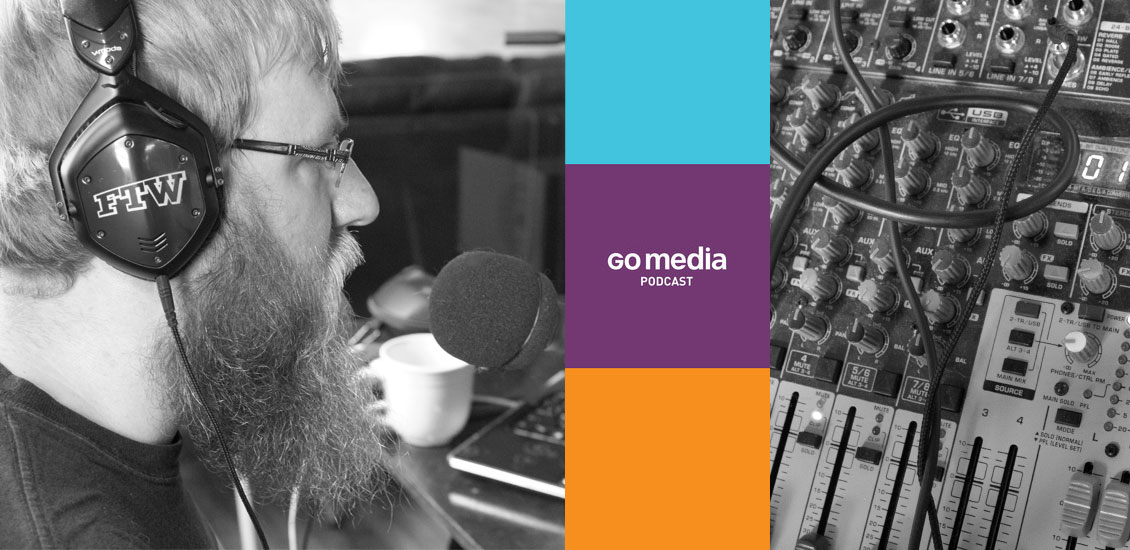Blog

Tools We Use To Produce The Go Media Podcast
Ever wonder what kind of tools you need to put together a great podcast?
I don’t know about great, but I can at least tell you about the tools we use to produce the Go Media podcast. If you aren’t familiar, the Go Media Podcast is dedicated to tips, tricks, and tales of the business-minded artist and designer. It’s our way of letting you inside our studio to learn about the ups and downs we face here at Go Media and how we’re dealing with them.
Every episode deals with at least one topic that we’ve run into head first and how we solved the problem or at least, how we’re currently dealing with it. So far, we’ve talked about how and why we price projects, how we adjusted methods to land more projects, as well as how we keep momentum going when inspiration (and finances) aren’t in the best of shapes.
So far, we’ve recorded just over a dozen episodes. The process has changed dramatically from where we were at episode one. So, instead of going through the entire history of our setup, I’ll just explain how we put together each episode now.
The Process
We set up the studio in our conference room.

We wanted to put something together that was in the office, but offset from the staff so our loud, on-air antics aren’t interrupting their day. Plus, we wanted to be able to capture some of the staff background sound to add a bit of atmosphere to the recording.
The main piece of hardware we use is a Behringer X1204USB Mixer. It’s a 12-channel mixer, which allows for up to 6 mics or line-ins. During a normal episode, we run 3 mics in tracks 1-3. The mixer runs just under $200 on Amazon. This also gives us the flexibility to mix the audio while recording. We run the mixer into a laptop through a USB input to record.

The mics we chose to use are Samson Q2U. They can plug directly into the mixer or can even be used as a desktop mic through USB. We wanted something versatile that we could use with or without a mixer. Those ran about $50 a piece. We also have Onstage Boom mic stands, but the mics came with desktop stands as well, which we use depending on the situation.
Bill and Jeff currently sit across from one another on one side of the table, and I sit behind the mixer and laptop. We use a similar set up when it’s just Simon and I talking about the Arsenal.
For WMC Fest Speaker Interviews, we used an Ipad and Skype. We ran the Ipad audio out into track 4.
To prepare for an episode, we use Google Docs. Every episode, we create a new doc where we can collaborate on the pre-show show notes. We then use those show notes in our final post on the Zine. Jeff and Bill normally bring a printout of those notes into the studio with them, however I tend to access the doc through my tablet.
To record, we use Audacity. Audacity is a free, open source, cross-platform software for recording and editing sounds. We bring the audio in from the mixer through a USB input, directly into Audacity. We also use Audacity to edit and use 4 basic effects on the final export:
- Noise Removal – This one is no longer as important as it was when we first started, but every once in awhile, it’s nice to take out the crashing of plates from the kitchen, or the faint sound of sirens in the neighborhood, or the door slamming shut on a windy day. I normally apply this first, before making any other changes, that way we can get a good sample of “white noise” to choose from. Plus, it easily eliminates excess static and fuzz that you generally get when recording audio.
- Chris’s Dynamic Compressor Plugin – I use this to make sure everyone is, generally speaking, talking at the same levels.
- Truncate Silence – Once we clip the ends and remove the unnecessary bits, I run a truncate silence to close some of the gaps. It beats doing it manually.
- Fade In/Out – This is how we accomplish the fade ins/outs of all music we use during the episode.
Starting with Episode 10, we decided to start streaming live every time we record. To do this, we use two apps: Mixlr for streaming the audio and Tlk.io for chatting with our listeners.
- Mixlr lets us stream high quality, live stereo sound across the internet. It also records the stream and allows us to download a 128kbps audio file through a Dropbox account. They have an iOS app so that you can also listen while on the go, with an Android app in the works. The premium version of Mixlr also gives us a direct download link and the ability to embed the stream on our site.
- Tlk.io gives us an embeddable chatroom that can be accessed from any device that can access the web. We’ve embedded it at http://gomediazine.com/live so that, when you’re listening to the conversation, you can also add your thoughts, which we can then bring into it on-air.
We plan on taking all episodes live after WMC Fest. Hopefully, we can get a regular schedule going.
In short, here are the tools we use to produce the podcast:
Tools
Software
- Audacity for single track recording and editing
- Mixlr for live streaming
- Tlk.io for live chat
- Google Drive for show note collaboration
Hardware
- Behringer X1204USB Mixer
- 3 Samsung Q2U Mics and cables
- 3 Onstage Boom Mic Stands
- iPad for Skype calls
So yeah, that’s the gist of the what we use to record, edit, and produce the Go Media Podcast. Haven’t listened to it yet? Take it from me, you should.
![c310e5a2f9ed11e2873722000a1fcfc8_7[1]](http://s3.gomedia.us/wp-content/uploads/2013/08/c310e5a2f9ed11e2873722000a1fcfc8_71-540x540.jpg)